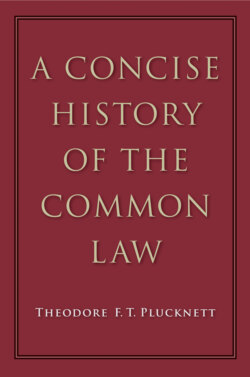Читать книгу A Concise History of the Common Law - Theodore F. T. Plucknett - Страница 95
На сайте Литреса книга снята с продажи.
A MANORIAL COURT AT WORK
ОглавлениеAn interesting example of a manorial court (with a court leet held, as usual, twice a year) is to be found at Littleport near Ely, and a few extracts from its rolls2 will give a good idea of the vigour and usefulness of such courts, and explain, incidentally, why some boroughs found it useful to acquire from the Crown a grant of leet jurisdiction. As an example of its most solemn form of procedure we may take what looks very much like an original writ3 addressed by the lord of the court (the bishop of Ely) to his steward in 1316: but more typical of its usual activities are the numerous cases of petty offences, principally larcenies, which are punished by banishment4 and offences against the by-laws relating to the agricultural arrangements of the village—and like most mediaeval communities there was a strong protectionist policy which even went so far as to fine persons who “exported” eggs “to the great destruction” of the people.5 Two men incurred a fine for having “falsely, maliciously and in contempt of the lord, defamed his court by saying that no one can obtain justice there”.6 Civil cases illustrate the wide variety of remedy obtainable in the court. A seller who warranted two ewes as sound has to pay fine and damages when they turned out to be diseased,7 and the owner of a dog has to pay for the damage it does:8 Rose called Ralph a thief, and Ralph called her a whore, and so both are fined, and since the trespass done to Ralph exceeds the trespass done to Rose she must pay him damages of twelve pence for the difference.9 Slandering a man’s goods so that he lost a sale is visited with fine and damages.10 Beatrice, who should have made a shirt for Agnes, has to pay one penny damages for failing to do so, and in at least two cases of contracts to do work, the court ordered the defaulter to be distrained until he did it—remarkable examples of specific performance.11 These and many other entries show how vigorous and flexible was this manorial law in the period around the year 1300, when it is certain that the common law administered by the king’s courts at Westminster gave no remedy for the breach of simple contracts, nor for such torts as slander.
In these cases it will be seen that prosecutions are on the presentment of a jury. In manors which had not received (or had not assumed) this royal right, it was the bailiff who prosecuted.1
The efficiency of the manorial form of government is attested to a remarkable degree in the history of Manchester. This rich and flourishing community was a manor belonging to the Mosley family, who purchased the manorial rights in 1596 and continued to enjoy them until 1845, when the municipality (created in 1838) bought them for £200,000.
“The lord of the manor had the right to tax and toll all articles brought for sale into the market of the town. But, though the inhabitants were thus to a large extent taxed for the benefit of one individual, they had a far greater amount of local self-government than might have been supposed, and the court leet, which was then the governing body of the town, had, though in a rudimentary form, nearly all the powers now possessed by municipal corporations.”2
